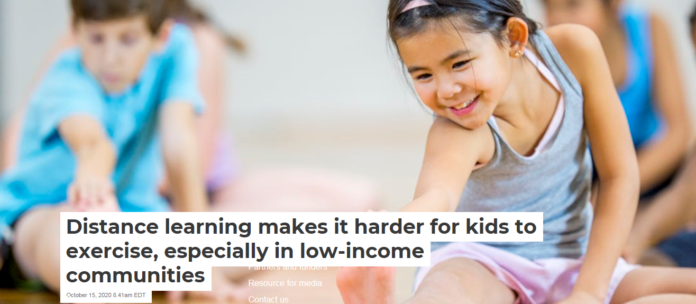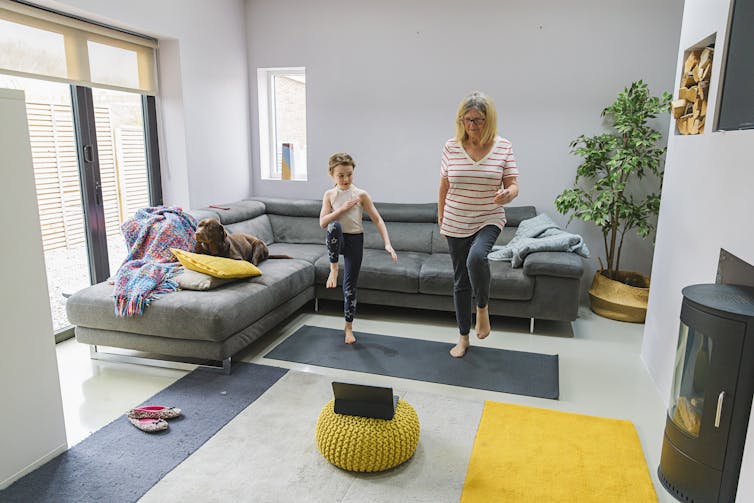

Katelyn Esmonde, Johns Hopkins University and Keshia Pollack Porter, Johns Hopkins Bloomberg School of Public Health
This fall hasn’t felt much like “back to school” for many children. Instead, many are staying at home and attending virtual classes indefinitely.
According to the Center on Reinventing Public Education, a nonpartisan research center, about 25% of U.S. school districts have started the year fully remote. This means that children will miss out on vital opportunities for educational, social and emotional development. And, as is familiar during this pandemic, the impact will be unequal: Children in underresourced districts are more likely to be remote learners. These children are hardest hit by school closures as they are more likely to lack access to necessary technologies and are less likely to receive parental help with their learning. They will also lose out on easy access to school meals.
But there’s another harm done by school closures: a child’s ability to be physically active. We are researchers at Johns Hopkins University studying physical activity and its impact on public health. Based on our research, we believe the pandemic is exacerbating health disparities among children and having significant impacts on their physical, social and cognitive development.

Justin Paget via Getty Images
No gym classes, no team sports
Children not in school don’t have recess or physical education classes. They aren’t walking to school or to a bus stop. Generally, they can’t participate in school teams or clubs that promote physical activity either (although in some school districts, team sports may go ahead even while in-person education does not).
What’s more, children have traditionally been less physically active in the summer than during the school year, with notable differences by race and ethnicity. And given the punishing trajectory of the pandemic, it is not clear when those prospects for physical activity will be available again.
The U.S. Department of Health and Human Services recommends that children between ages 6 and 17 engage in one hour of moderate to vigorous physical activity per day. That can improve a child’s physical and mental health and prevent the onset of chronic disease, including Type 2 diabetes, heart disease and some cancers.
Physical activity and active play can also be a source of joy for children. As they socialize with peers, they find pleasure in moving their bodies and developing their strength and physical literacy. Many of us look back fondly on childhood memories of soccer games and running around until we tire ourselves out, a delight every child deserves.
Schools, of course, are not perfect when it comes to meeting children’s physical activity needs. Physical education is chronically underfunded, and Black and Latino children typically lose out the most. Even so, schools provide some opportunities for children to be well and healthy.

SDI Productions via Getty Images
Low-income communities are hurt the most
A child’s decrease in physical activity is not only a public health issue. It’s also a matter of fairness.
Prior to the pandemic, children from low-income communities and communities of color already experienced greater challenges in accessing physical activity opportunities. They were already less likely to meet physical activity recommendations because of a lack of affordable options. There are also safety issues, challenges to parental support and a neighborhood environment that doesn’t foster play and physical activity.
As more activities have moved outdoors to decrease the risk of virus spread, these inequities are felt more than ever before. In many cases, the parents of children in low-income communities are essential workers who can’t be home to support either learning or physical activity. Private backyards for play are frequently missing, and public spaces are often inadequate.
The weather poses additional barriers. Because of less green space and tree canopy, low-income neighborhoods tend to be hotter in the summer, sometimes significantly so, than higher-income neighborhoods in the same city. They also have poorer air quality. In the winter, many families can’t afford a warm coat, which makes outdoor play more difficult.
Promoting outdoor play
These are not intractable problems. Solutions exist to promote a child’s active outdoor play. Some strategies work in all settings, although urban, suburban and rural environments will have to vary approaches. But in all cases, it’s essential that children have the clothing and nourishment they need to play outside through all types of weather.
First, supervised play can take place on unused school yards through policies like joint use agreements. This should not be a heavy lift, as schools are usually in centralized locations and they already support active play.
[Deep knowledge, daily. Sign up for The Conversation’s newsletter.]
Second, many cities worldwide have increased access to public spaces during the pandemic. They have closed down entire streets and driving lanes and replaced them with activity areas. These efforts can be expanded to focus on children by creating specialized spaces for child-friendly games. This was already happening before the pandemic: Initiatives such as Play Streets, where neighborhood blocks are shut down to promote play, were becoming popular. This can be a model, albeit with additional safeguards built in to promote physical distancing.
The pandemic has created previously unimaginable challenges for so many of us. Children’s health and well-being, particularly for those facing significant barriers, must be a priority.![]()
Katelyn Esmonde, Postdoctoral Fellow, Johns Hopkins University and Keshia Pollack Porter, Professor of Public Health, Johns Hopkins Bloomberg School of Public Health
This article is republished from The Conversation under a Creative Commons license. Read the original article.



















